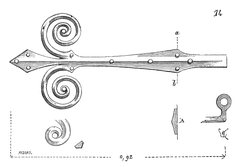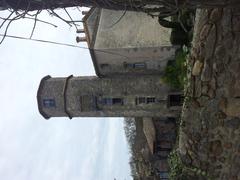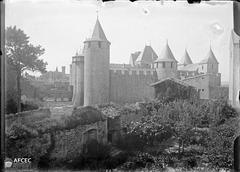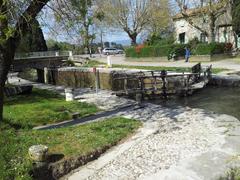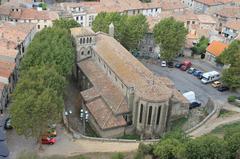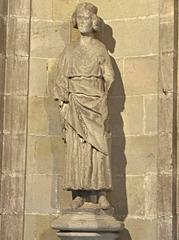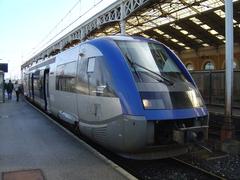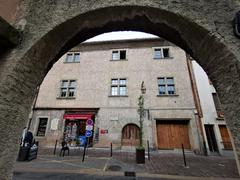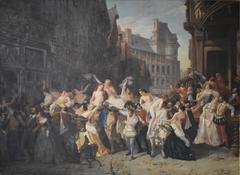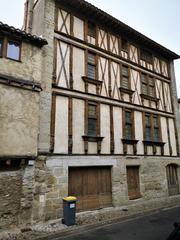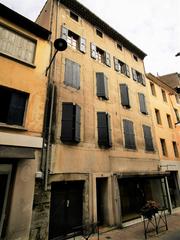A Comprehensive Guide to Autoroute des Deux Mers and Carcassonne, France
Date: 18/07/2024
Introduction
The Autoroute des Deux Mers, a vital transportation corridor in France, weaves a path through the nation’s rich history, from ancient Roman roads to contemporary highways. This route serves not only as a practical connection between the Atlantic and Mediterranean coasts but also as a conduit for cultural and economic exchange. A key segment of this route, the A61, traverses the historic city of Carcassonne, a UNESCO World Heritage site known for its medieval architecture and strategic significance throughout the centuries. (source)
The historical roots of the Autoroute des Deux Mers can be traced back to the Via Aquitania, an ancient Roman road constructed in the 1st century BC that facilitated trade, military movements, and cultural dissemination across the Roman Empire. This ancient infrastructure laid the groundwork for the development of modern routes, contributing to economic growth and cultural integration in the region. (source)
Carcassonne, one of the most prominent cities along this route, offers a unique glimpse into the medieval past with its well-preserved fortifications, including the famed Cité de Carcassonne. The city’s history is marked by significant events such as the Cathar Crusade and its role as a border fortress. Today, the city’s historical significance, combined with the accessibility provided by the A61, has made it a major tourist destination. (source)
This comprehensive guide delves into the historical, cultural, and economic aspects of the Autoroute des Deux Mers and Carcassonne. It provides practical information for visitors, including details on visiting hours, ticket prices, and nearby attractions, while also examining the broader impact of this route on the local economy and tourism industry.
Table of Contents
- [Introduction](#introductionintroduction)
- [Exploring the Historical Significance of the Autoroute des Deux Mers - From Roman Roads to Modern Highways](#exploring-the-historical-significance-of-the-autoroute-des-deux-mers---from-roman-roads-to-modern-highwaysexploring-the-historical-significance-of-the-autoroute-des-deux-mers---from-roman-roads-to-modern-highways)
- [Ancient Roots - Roman Roads and Trade Routes](#ancient-roots---roman-roads-and-trade-routesancient-roots---roman-roads-and-trade-routes)
- [Carcassonne - A Medieval Stronghold on the Route](#carcassonne---a-medieval-stronghold-on-the-routecarcassonne---a-medieval-stronghold-on-the-route)
- [Modern Development - The Autoroute and Tourism](#modern-development---the-autoroute-and-tourismmodern-development---the-autoroute-and-tourism)
- [Visitor Information](#visitor-informationvisitor-information)
- [Nearby Attractions and Travel Tips](#nearby-attractions-and-travel-tipsnearby-attractions-and-travel-tips)
- [Special Events and Guided Tours](#special-events-and-guided-toursspecial-events-and-guided-tours)
- [FAQ](#faqfaq)
- [Exploring Carcassonne - Visiting Hours, Tickets, and Top Attractions](#exploring-carcassonne---visiting-hours-tickets-and-top-attractionsexploring-carcassonne---visiting-hours-tickets-and-top-attractions)
- [Introduction](#introductionintroduction-1)
- [The Cité de Carcassonne - A Medieval Masterpiece](#the-cité-de-carcassonne---a-medieval-masterpiecethe-cité-de-carcassonne---a-medieval-masterpiece)
- [A Walk Through Time](#a-walk-through-timea-walk-through-time)
- [Immersive Historical Sites](#immersive-historical-sitesimmersive-historical-sites)
- [Beyond the Walls](#beyond-the-wallsbeyond-the-walls)
- [The Bastide Saint-Louis - A City of New Beginnings](#the-bastide-saint-louis---a-city-of-new-beginningsthe-bastide-saint-louis---a-city-of-new-beginnings)
- [A Grid of History](#a-grid-of-historya-grid-of-history)
- [Place Carnot](#place-carnotplace-carnot)
- [Canal du Midi](#canal-du-midicanal-du-midi)
- [Beyond the City Walls - Exploring the Surrounding Area](#beyond-the-city-walls---exploring-the-surrounding-areabeyond-the-city-walls---exploring-the-surrounding-area)
- [Cathar Castles](#cathar-castlescathar-castles)
- [Wine Tasting](#wine-tastingwine-tasting)
- [Outdoor Activities](#outdoor-activitiesoutdoor-activities)
- [Practical Information for Visitors](#practical-information-for-visitorspractical-information-for-visitors)
- [Frequently Asked Questions](#frequently-asked-questionsfrequently-asked-questions)
- [Economic Impact of the Autoroute des Deux Mers on Carcassonne - Tourism, Trade, and Local Economy](#economic-impact-of-the-autoroute-des-deux-mers-on-carcassonne---tourism-trade-and-local-economyeconomic-impact-of-the-autoroute-des-deux-mers-on-carcassonne---tourism-trade-and-local-economy)
- [Introduction](#introductionintroduction-2)
- [Enhanced Accessibility and Tourism](#enhanced-accessibility-and-tourismenhanced-accessibility-and-tourism)
- [Visitor Information and Travel Tips](#visitor-information-and-travel-tipsvisitor-information-and-travel-tips)
- [Nearby Attractions and Accessibility](#nearby-attractions-and-accessibilitynearby-attractions-and-accessibility)
- [Facilitating Trade and Commerce](#facilitating-trade-and-commercefacilitating-trade-and-commerce)
- [Challenges and Considerations](#challenges-and-considerationschallenges-and-considerations)
- [Future Outlook](#future-outlookfuture-outlook)
- [FAQ](#faqfaq-1)
- [Call to Action](#call-to-actioncall-to-action)
- [Conclusion](#conclusionconclusion)
- [References](#referencesreferences)
Exploring the Historical Significance of the Autoroute des Deux Mers - From Roman Roads to Modern Highways
The Autoroute des Deux Mers is not just a modern marvel of engineering, but a pathway through history, tracing back to ancient times and intertwined with the development of France as a nation. In this article, we explore its rich historical significance and provide practical information for visitors.
Ancient Roots - Roman Roads and Trade Routes
The Autoroute des Deux Mers, particularly the A61 section, largely follows the path of the ancient Roman road Via Aquitania. This road, built by the Romans in the 1st century BC, connected Narbonne, a major Roman port, to Toulouse and further north to Bordeaux. The Via Aquitania was instrumental in:
- Facilitating trade: It allowed for the efficient transport of goods, including agricultural produce, wine, and minerals, between the Iberian Peninsula and the rest of the Roman Empire.
- Military movement: The road served as a vital artery for the Roman legions, enabling them to quickly deploy troops and maintain control over the newly conquered Gaul.
- Cultural exchange: The Via Aquitania facilitated the spread of Roman culture, language, and ideas throughout the region.
The route continued to be a significant trade route throughout the Middle Ages, connecting the Atlantic coast with the Mediterranean Sea. This bustling trade route fostered economic growth and cultural exchange between different parts of France.
Carcassonne - A Medieval Stronghold on the Route
Carcassonne, a UNESCO World Heritage site, stands as a testament to the historical significance of the Autoroute des Deux Mers route. This fortified city, with its imposing ramparts and towers, has witnessed centuries of history, from its Roman origins to its role as a strategic stronghold during the Middle Ages.
- Cathar Crusade: Carcassonne played a pivotal role in the Albigensian Crusade (1209-1229), a 20-year conflict that saw the Catholic Church attempt to suppress the Cathar religious movement in southern France. The city, a Cathar stronghold, was besieged and captured by the crusaders.
- Border Fortress: Following the crusade, Carcassonne became a strategically important border fortress between France and the Crown of Aragon (present-day Spain). Its fortifications were strengthened, and it served as a symbol of royal power.
- Decline and Restoration: The city’s military importance declined after the Treaty of the Pyrenees (1659), which shifted the border south. Carcassonne fell into disrepair until the 19th century, when it underwent a major restoration led by architect Eugène Viollet-le-Duc.
Modern Development - The Autoroute and Tourism
The construction of the Autoroute des Deux Mers in the 20th century brought about significant changes to the region. The highway, while a modern addition, has further enhanced the historical significance of the route by:
- Boosting tourism: The Autoroute des Deux Mers has made it easier for tourists to access Carcassonne and other historical sites along the route, contributing significantly to the region’s tourism industry.
- Connecting communities: The highway has improved connectivity between towns and cities along its path, fostering economic development and cultural exchange.
- Preserving heritage: The construction of the Autoroute des Deux Mers involved archaeological surveys and preservation efforts, leading to the discovery and protection of numerous historical artifacts and sites.
Visitor Information
For those planning to visit Carcassonne and other historical sites along the Autoroute des Deux Mers, here is some practical information:
- Carcassonne Visiting Hours: The medieval city is generally open to visitors throughout the year, but specific opening hours can vary. It is advisable to check the official website for the most up-to-date information.
- Carcassonne Tickets: Entrance to the city is free, but there may be fees for guided tours and certain attractions within the city. Tickets can be purchased on-site or online.
- Accessibility: The autoroute and major historical sites are accessible by car. Public transportation options are also available, including trains and buses.
Nearby Attractions and Travel Tips
While traveling along the Autoroute des Deux Mers, consider visiting these nearby attractions:
- Toulouse: Known as ‘La Ville Rose’ (The Pink City), Toulouse boasts a rich history, vibrant culture, and impressive architecture. Key sites include the Basilica of Saint-Sernin and the Capitole de Toulouse.
- Narbonne: This city offers a glimpse into Roman history with its well-preserved Horreum and the Narbonne Cathedral.
- Bordeaux: Famous for its wine, Bordeaux also offers historical landmarks like the Place de la Bourse and the Bordeaux Cathedral.
Special Events and Guided Tours
- Special Events: Carcassonne hosts several events throughout the year, including medieval festivals, concerts, and fireworks displays. Check the local tourism website for event schedules.
- Guided Tours: Guided tours of Carcassonne and other historical sites are available and highly recommended for a richer experience. These tours provide in-depth information and unique insights into the history and significance of the sites.
FAQ
- What are the visiting hours for Carcassonne? Visiting hours can vary; it is best to check the official site for the latest information.
- How much do tickets cost for the Autoroute des Deux Mers? There is no cost for driving on the Autoroute des Deux Mers itself, but toll fees may apply at certain sections. Entrance to Carcassonne is free, with additional costs for guided tours.
- What are the must-see historical sites along the Autoroute des Deux Mers? Must-see sites include Carcassonne, Toulouse, Narbonne, and Bordeaux.
Visit and Stay Up to Date
Embark on a journey through time along the Autoroute des Deux Mers. Download the Audiala mobile app, explore other related posts, and follow our social media for the latest updates.
Exploring Carcassonne - Visiting Hours, Tickets, and Top Attractions
Carcassonne, strategically located along the scenic Autoroute des Deux Mers (A61), is a treasure trove of medieval history and vibrant culture. This guide provides detailed visitor information, including the Cité de Carcassonne visiting hours, tickets, and the city’s top attractions.
Introduction
Nestled in the heart of the Languedoc-Roussillon region, Carcassonne offers an enchanting mix of historical sites, cultural experiences, and natural beauty. Whether you’re a history buff, a wine enthusiast, or an outdoor adventurer, Carcassonne has something to offer. This article will guide you through the must-see attractions, practical travel tips, and essential visitor information.
The Cité de Carcassonne - A Medieval Masterpiece
Dominating the landscape of Carcassonne is the magnificent Cité, a UNESCO World Heritage site and one of the most impressive fortified cities in Europe.
A Walk Through Time
The Cité’s history stretches back to the Gallo-Roman period, with significant developments during the 13th and 14th centuries under the rule of the Trencavel family and later, the French monarchy. Visitors can explore the well-preserved ramparts, towers, and gates, offering a glimpse into medieval military architecture.
Immersive Historical Sites
Within the Cité’s walls lie several notable sites:
- The Château Comtal: This 12th-century castle, once home to the Viscounts of Carcassonne, now houses a museum showcasing the city’s history.
- Visiting Hours: Daily from 10 AM to 6 PM (hours may vary seasonally).
- Tickets: Adults €9.50, reduced rates for children, students, and seniors.
- The Basilica of Saints Nazarius and Celsus: This stunning basilica features a blend of Romanesque and Gothic architecture, with beautiful stained-glass windows and intricate carvings.
- The Ramparts Walk: A walk along the ramparts provides breathtaking panoramic views of the city and surrounding countryside.
Beyond the Walls
The Cité is not just a historical monument; it’s a vibrant hub with shops, restaurants, hotels, and museums, offering a taste of medieval life with modern amenities.
The Bastide Saint-Louis - A City of New Beginnings
Across the Aude River from the Cité lies the Bastide Saint-Louis, a 13th-century planned city built after the expulsion of the Cathars from Carcassonne.
A Grid of History
The Bastide’s grid-like street plan, a hallmark of medieval urban planning, contrasts with the Cité’s organic layout. This design reflects the era’s emphasis on order and functionality.
Place Carnot
At the heart of the Bastide lies Place Carnot, a bustling square lined with cafés and restaurants, perfect for soaking up the city’s atmosphere. The covered market held here on Tuesdays, Thursdays, and Saturdays offers a sensory experience of local produce and crafts.
Canal du Midi
A leisurely stroll along the Canal du Midi, another UNESCO World Heritage site, is a must-do. This 17th-century canal, connecting the Atlantic Ocean to the Mediterranean Sea, played a vital role in Carcassonne’s economic growth. Boat tours offer a unique perspective of the city from the water.
Beyond the City Walls - Exploring the Surrounding Area
Carcassonne’s charm extends beyond its city walls. The surrounding Languedoc-Roussillon region offers a wealth of attractions for those looking to delve deeper into the area’s history, culture, and natural beauty.
Cathar Castles
The region is dotted with Cathar castles, remnants of the Cathar heresy that once flourished here. Château de Quéribus and Château de Peyrepertuse, perched high on rocky outcrops, offer stunning views and a glimpse into the region’s turbulent past.
Wine Tasting
The Languedoc-Roussillon region is renowned for its wines. Numerous vineyards offer tours and tastings, allowing visitors to sample the local vintages and learn about the winemaking process.
Outdoor Activities
The surrounding countryside offers ample opportunities for outdoor enthusiasts. Hiking, cycling, and horseback riding trails wind through vineyards, forests, and rolling hills, providing scenic views and a chance to connect with nature.
Practical Information for Visitors
- Getting There: Carcassonne is easily accessible by car via the Autoroute des Deux Mers (A61). The city also has a train station with connections to major French cities.
- Getting Around: The Cité is easily explored on foot. The Bastide is also walkable, and a local bus network connects the two areas.
- Accommodation: Carcassonne offers a wide range of accommodation options, from budget-friendly hostels to luxurious hotels within the Cité walls.
- Food and Drink: The city boasts a diverse culinary scene, with restaurants serving traditional French cuisine, regional specialties, and international flavors. Be sure to try the cassoulet, a hearty bean stew, and sample the local wines.
Frequently Asked Questions
- What are the visiting hours for the Cité de Carcassonne? The Cité is open daily from 10 AM to 6 PM, but hours may vary seasonally.
- How much do tickets to the Cité cost? Tickets for adults are €9.50, with reduced rates for children, students, and seniors.
- Are there any guided tours available? Yes, guided tours are available and can be booked through the official website or local tour operators.
- What are some nearby attractions? Nearby attractions include the Cathar castles, the Canal du Midi, and various vineyards for wine tasting.
- Is Carcassonne accessible for travelers with disabilities? Many areas of Carcassonne, including the Cité, have made efforts to be accessible, but some historic sites may present challenges. It’s best to check specific accessibility details in advance.
Stay Up to Date
For the latest updates on events, guided tours, and visitor information, follow Carcassonne on social media or download the official Carcassonne mobile app. Check out our other related posts for more travel inspiration.
Carcassonne, with its medieval splendor, rich history, and vibrant culture, offers a captivating experience for travelers. Whether exploring the ramparts of the Cité, strolling through the Bastide’s charming streets, or venturing into the surrounding countryside, a visit to Carcassonne is sure to be a memorable one.
Economic Impact of the Autoroute des Deux Mers on Carcassonne - Tourism, Trade, and Local Economy
Introduction
The Autoroute des Deux Mers, particularly the A61 segment that passes through Carcassonne, has significantly influenced the city’s economy. As a vital transportation link between the Atlantic and the Mediterranean, its impact reaches far beyond mere connectivity. This article explores how the A61 has shaped Carcassonne’s tourism, trade, and overall economic landscape.
Enhanced Accessibility and Tourism
The A61 has dramatically improved Carcassonne’s accessibility for tourists from across France and Europe, contributing substantially to the local economy.
- Increased Visitor Numbers: Enhanced accessibility has led to a significant rise in visitor numbers to Carcassonne. While precise figures directly linked to the A61 are challenging to isolate, the city attracts over 2 million visitors annually (source). Many of these visitors arrive by car, facilitated by the A61.
- Boost to Local Businesses: The influx of tourists has increased revenue for local businesses, including hotels, restaurants, souvenir shops, and tour operators.
- Job Creation: The thriving tourism sector, fueled by the A61’s accessibility, has created numerous jobs, bolstering the local economy.
Visitor Information and Travel Tips
- Carcassonne Visiting Hours: Most attractions in Carcassonne, including the famous Cité de Carcassonne, are open daily from 10 AM to 6 PM. However, hours may vary seasonally.
- Carcassonne Tickets: Entry to the Cité de Carcassonne requires a ticket, which can be purchased online or at the entrance. Prices range from €9 to €12 for adults, with discounts for children and seniors.
- Guided Tours: Numerous guided tours are available, offering deeper insights into Carcassonne’s rich history. It’s advisable to book these tours in advance.
Nearby Attractions and Accessibility
- Nearby Attractions: In addition to the Cité de Carcassonne, visitors can explore nearbyattractions such as the Canal du Midi, the Basilica of Saints Nazarius and Celsus, and the Carcassonne Museum of Fine Arts.
- Accessibility: Carcassonne is well-connected by the A61, making it easily accessible by car. The city also has a train station with regular services to major cities like Toulouse and Narbonne.
Facilitating Trade and Commerce
Beyond tourism, the A61 is crucial for trade and commerce in Carcassonne and the surrounding region.
- Efficient Goods Transportation: The highway enables swift transportation of goods, connecting local businesses to markets across France and beyond. This is vital for industries such as agriculture, manufacturing, and logistics.
- Attracting Investment: Improved connectivity makes Carcassonne more attractive to businesses and investors, potentially leading to the establishment of new industries and businesses, thereby diversifying the local economy.
- Real Estate and Development: The A61’s influence extends to the real estate market, with improved accessibility driving up property values and stimulating new development projects, both residential and commercial.
Challenges and Considerations
While the A61’s impact on Carcassonne is largely positive, some challenges and considerations remain:
- Seasonal Dependence: Carcassonne’s tourism industry, heavily reliant on the A61, experiences significant seasonality, leading to fluctuations in employment and revenue.
- Environmental Impact: Major infrastructure projects like the A61 have environmental implications. Authorities must implement measures to mitigate these impacts.
- Preservation of Heritage: Balancing economic benefits with the preservation of Carcassonne’s historic significance is an ongoing challenge.
Future Outlook
The Autoroute des Deux Mers will continue to play a pivotal role in Carcassonne’s economic future. As the city enhances its tourism infrastructure and attracts new businesses, the A61 will remain a critical asset. Sustainable development practices, responsible tourism management, and continued investment in infrastructure will be key to maximizing the highway’s positive economic impact while mitigating potential drawbacks.
FAQ
- What are the visiting hours for Carcassonne? Most attractions are open from 10 AM to 6 PM, with seasonal variations.
- How much do Carcassonne tickets cost? Ticket prices range from €9 to €12 for adults, with discounts available for children and seniors.
- What are some nearby attractions? Nearby attractions include the Canal du Midi, the Basilica of Saints Nazarius and Celsus, and the Carcassonne Museum of Fine Arts.
- How can I book guided tours? Guided tours can be booked online or at local tourist information centers.
Call to Action
For more information and updates, download our mobile app Audiala, check out our other related posts, and follow us on social media.
Conclusion
The Autoroute des Deux Mers stands as a testament to the enduring interplay between history, culture, and modern development. Tracing its origins to ancient Roman roads, this vital corridor has evolved to become a critical infrastructure piece, facilitating trade, tourism, and cultural exchange across France. (source)
Carcassonne, strategically positioned along the A61, exemplifies the rich historical tapestry and economic vibrancy that the Autoroute des Deux Mers supports. From the medieval grandeur of the Cité de Carcassonne to the bustling modernity of the Bastide Saint-Louis, the city offers a unique blend of historical and contemporary experiences. Enhanced accessibility provided by the A61 has not only boosted tourism but also stimulated local economic growth, underpinning the city’s prosperity. (source)
As we look to the future, the continued development and preservation of the Autoroute des Deux Mers, along with strategic initiatives to balance tourism with heritage conservation, will be crucial. By embracing sustainable practices and leveraging the economic benefits of improved connectivity, Carcassonne and other regions along this route can ensure their historical treasures are enjoyed by future generations. (source)
Embark on a journey through time along the Autoroute des Deux Mers and discover the historical and cultural gems that define Carcassonne. Stay informed and connected through resources like the Audiala mobile app and local tourism websites to make the most of your visit. (source)
References
- Exploring the Historical Significance of the Autoroute des Deux Mers - From Roman Roads to Modern Highways, 2024, Official Carcassonne Tourism Website https://www.tourisme-carcassonne.fr
- Exploring Carcassonne - Visiting Hours, Tickets, and Top Attractions, 2024, Official Carcassonne Tourism Website https://www.tourisme-carcassonne.fr
- Economic Impact of the Autoroute des Deux Mers on Carcassonne - Tourism, Trade, and Local Economy, 2024, Official Carcassonne Tourism Website https://www.tourisme-carcassonne.fr

